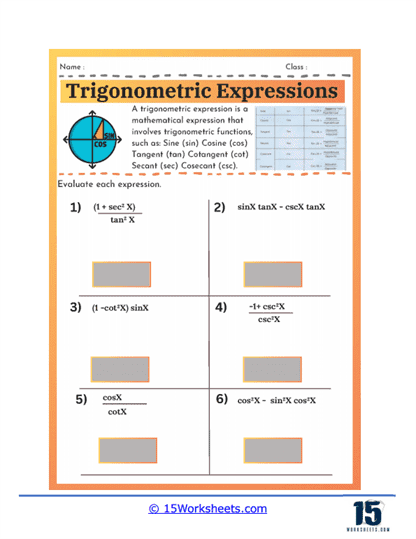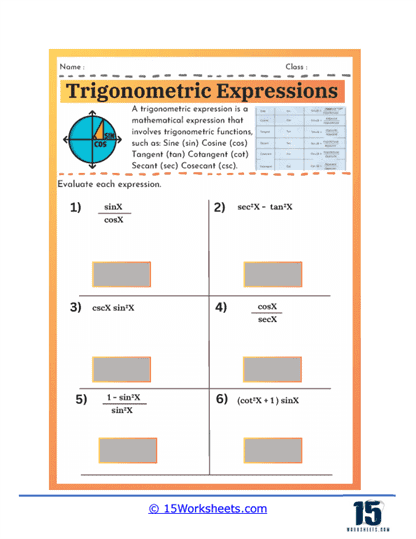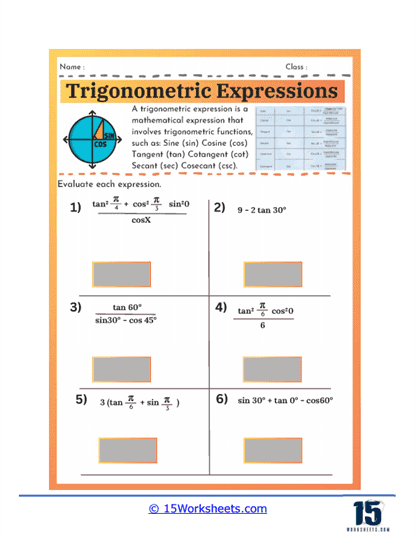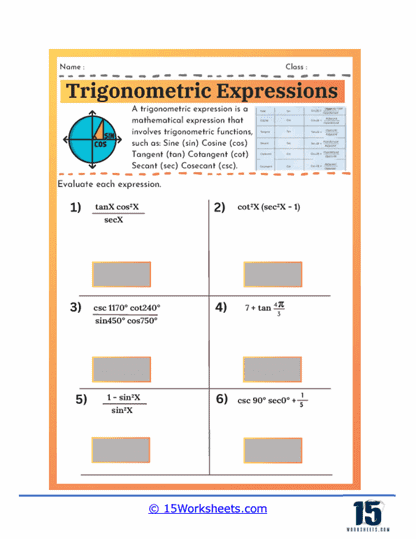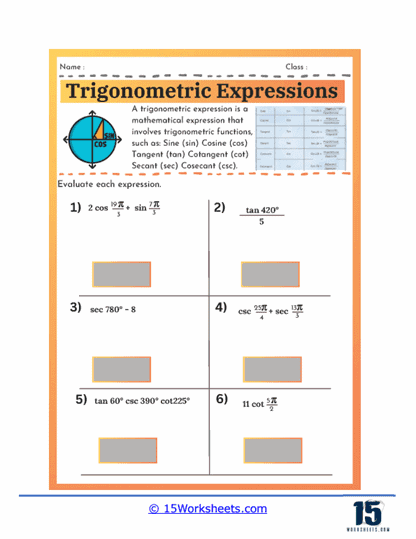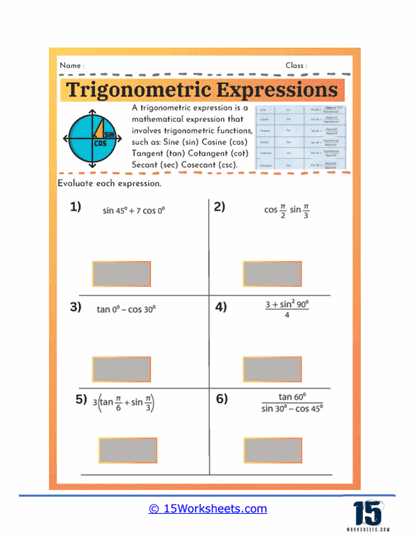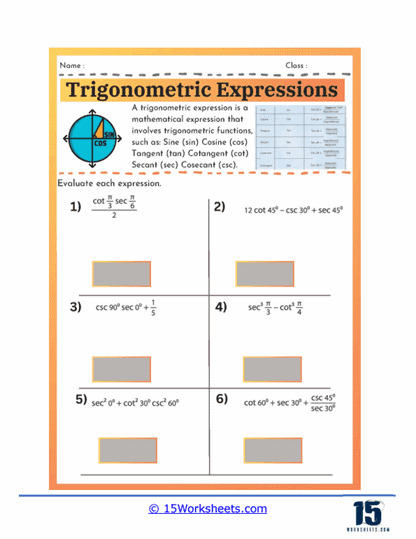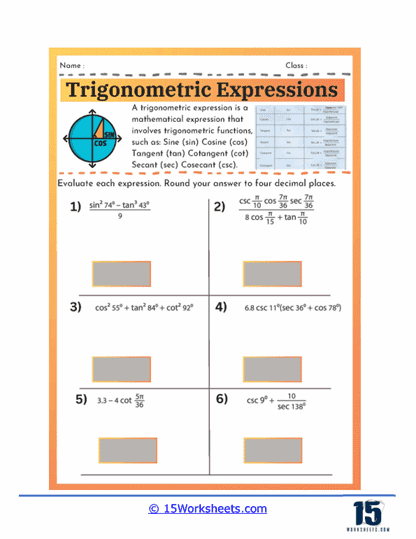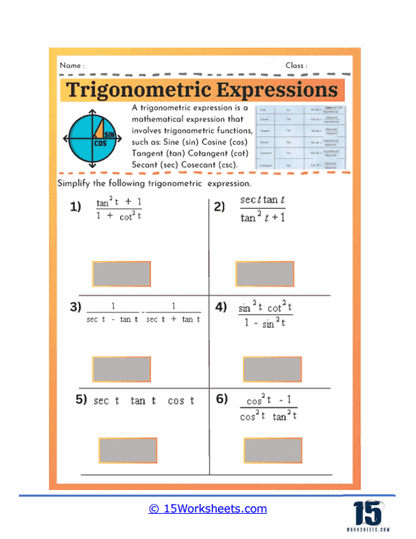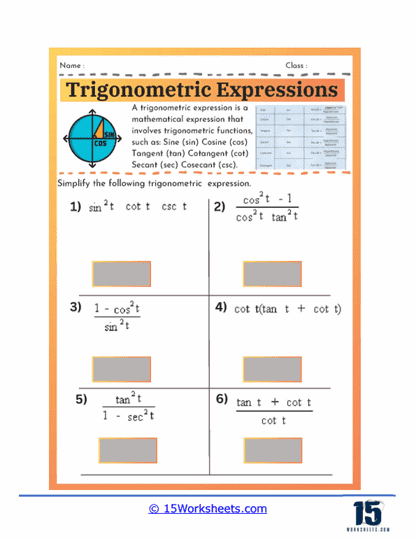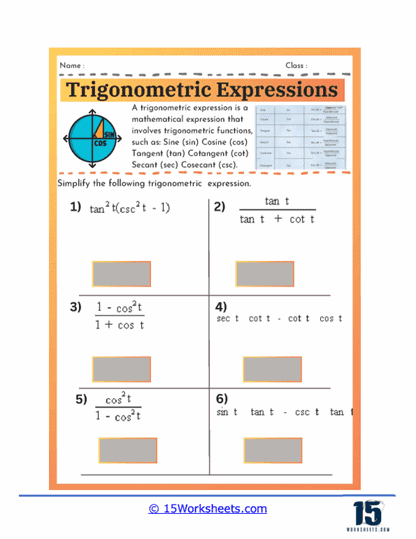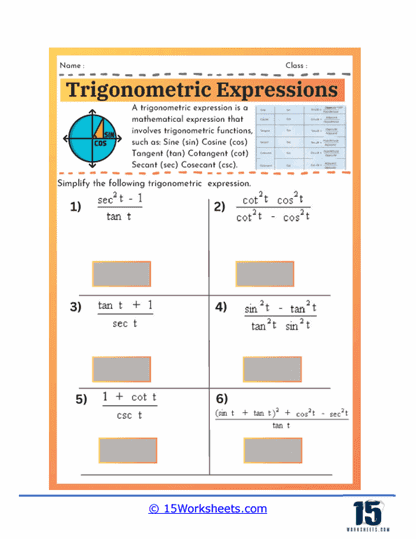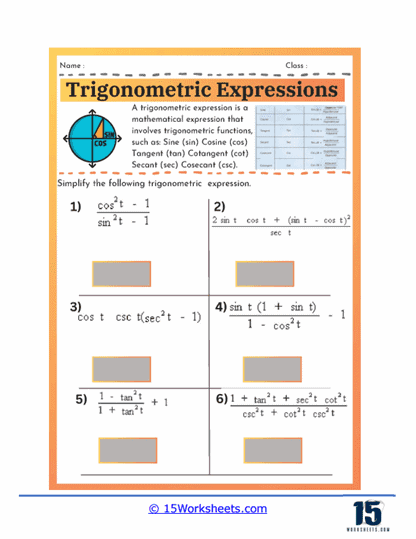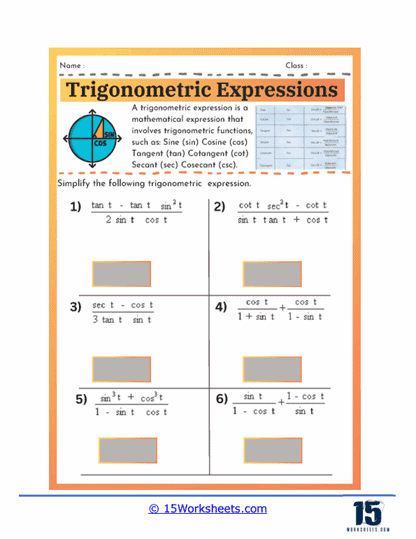Trigonometric Expressions Worksheets
About These 15 Worksheets
These worksheets are designed to help students grasp and master the fundamental concepts of trigonometry, a branch of mathematics that deals with the relationships between the angles and sides of triangles. These worksheets are a valuable resource for reinforcing students’ understanding of trigonometric identities, simplifying expressions, and solving equations involving trigonometric functions.
Trigonometric expressions involve the use of trigonometric functions such as sine (sin), cosine (cos), tangent (tan), cotangent (cot), secant (sec), and cosecant (csc). These functions are essential in understanding the properties of triangles, especially in relation to the unit circle, angles, and the ratios of a triangle’s sides. Trigonometric expressions are often used in various fields, including physics, engineering, and architecture, making it crucial for students to develop a strong foundation in this area of mathematics.
Types of Exercises
These worksheets typically contain various types of problems that target different skills in trigonometry. The exercises can range from simple evaluations to more complex simplifications and manipulations of trigonometric expressions. Below are the different types of problems you would commonly find on trigonometric expressions worksheets:
1. Evaluation of Trigonometric Expressions
One common type of exercise involves evaluating trigonometric expressions given a specific angle or value. In these problems, students are asked to substitute a particular angle into the trigonometric expression and then simplify the expression to find the numerical value. This type of problem helps students reinforce their understanding of the trigonometric functions and their values at various standard angles, such as 0°, 30°, 45°, 60°, and 90°.
For example, students might be given an expression like sin 45° + cos 0° and asked to evaluate it. Here, they would need to know that sin 45° equals Square root of 2 divided by 2 and cos 0° equals 1. Combining these, they would arrive at the final answer.
2. Simplification of Trigonometric Expressions
Another type of problem involves simplifying trigonometric expressions by using trigonometric identities. These problems challenge students to apply their knowledge of identities such as the Pythagorean identity, sum and difference identities, double-angle identities, and others. Simplifying expressions is a critical skill because it allows students to manipulate trigonometric equations into more manageable forms, which is often necessary in solving complex problems.
For instance, a student might be asked to simplify an expression like tan2 X + 1. Knowing the Pythagorean identity 1 + tan2 X = sec2, the student would simplify the expression to sec2X.
3. Solving Trigonometric Equations
Worksheets might also include exercises where students are required to solve trigonometric equations. These problems involve finding the angle(s) that satisfy the given trigonometric equation. Solving these equations often requires a combination of algebraic manipulation and the use of trigonometric identities.
For example, a problem could present an equation like sin X = 1/2 and ask the student to find all possible values of X within a given interval. The student would then determine the principal angle and use the unit circle to find all corresponding angles.
4. Applying Trigonometric Identities
Students might be tasked with proving trigonometric identities or using them to simplify expressions further. This type of problem is particularly important because it deepens students’ understanding of how trigonometric functions relate to one another. It also develops their ability to think critically and work through multi-step problems.
For instance, a problem might require students to prove that 1 + cot2 X = csc2 X. To do this, they would need to use the identity cot X = cos X / sin X and the Pythagorean identity sin2 X + cos2 X = 1 to show the equivalence.
What Are Trigonometric Expressions?
Trigonometric expressions are mathematical expressions that involve trigonometric functions, which are fundamental to the study of triangles and the relationships between their angles and sides. These expressions are composed of trigonometric functions such as sine, cosine, tangent, and their reciprocals: cosecant, secant, and cotangent. Each of these functions relates an angle in a right-angled triangle to ratios of two side lengths.
Components of Trigonometric Expressions
The primary Trigonometric functions include:
1. Sine (sin): Ratio of the opposite side to the hypotenuse.
2. Cosine (cos): Ratio of the adjacent side to the hypotenuse.
3. Tangent (tan): Ratio of the opposite side to the adjacent side.
4. Cosecant (csc), Secant (sec), and Cotangent (cot) are the reciprocals of sine, cosine, and tangent, respectively.
Trigonometric Identities: These are equations involving trigonometric functions that are true for every value of the occurring variables. Examples include Pythagorean identities, angle sum and difference identities, and double angle formulas.
Inverse Trigonometric Functions: These functions are used to find the angle that corresponds to a given trigonometric ratio.
Trigonometric Expressions in the Real World
Trigonometric expressions are used in various real-world applications that significantly impact decision-making in numerous fields, from engineering and architecture to physics, astronomy, and even economics. In engineering, for example, trigonometric expressions help in designing structures that must withstand different forces, such as bridges or buildings. By understanding the relationships between angles and distances, engineers can calculate load distributions and stress points more accurately, leading to safer and more efficient designs. In the realm of physics, trigonometric functions are crucial for analyzing wave patterns, whether they are sound waves, light waves, or water waves. This understanding enables physicists to predict behaviors and interactions of waves, which is essential for developing technologies like noise-canceling headphones, lasers, and even medical imaging devices like MRIs.
In astronomy, trigonometric expressions allow scientists to measure vast distances in space, such as the distance between Earth and a distant star, by using parallax and angular measurements. This ability to measure and predict celestial movements has profound implications for navigation, satellite placement, and understanding the universe’s structure. Moreover, in the field of economics, trigonometric functions are sometimes applied in the analysis of cyclical trends, such as market cycles or seasonal variations in data. By modeling these trends mathematically, economists can make more informed predictions about future market behavior, leading to better investment strategies and policy decisions.
In all these cases, the use of trigonometric expressions allows professionals to model, analyze, and predict complex situations with greater accuracy, leading to more informed and effective decision-making. Whether it’s ensuring the safety of a bridge, optimizing the performance of a technological device, or making strategic economic forecasts, the application of trigonometric expressions is integral to achieving precise, reliable outcomes.


